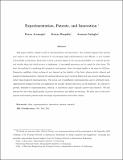Experimentation, Patents, and Innovation
Author(s)
Acemoglu, Daron; Bimpikis, Konstantinos; Ozdaglar, Asuman E.
DownloadAcemoglu_Experimentation patents.pdf (386.7Kb)
OPEN_ACCESS_POLICY
Open Access Policy
Creative Commons Attribution-Noncommercial-Share Alike
Terms of use
Metadata
Show full item recordAbstract
This paper studies a simple model of experimentation and innovation. Our analysis suggests that patents improve the allocation of resources by encouraging rapid experimentation and efficient ex post transfer of knowledge. Each firm receives a signal on the success probability of a project and decides when to experiment. Successes can be copied. First, we assume that signal qualities are the same. Symmetric equilibria involve delayed and staggered experimentation, whereas the optimal allocation never involves delays and may involve simultaneous experimentation. Appropriately designed patents implement the optimal allocation. Finally, we discuss the case when signals differ and are private information.
Date issued
2011-02Department
Massachusetts Institute of Technology. Department of Economics; Massachusetts Institute of Technology. Department of Electrical Engineering and Computer ScienceJournal
American Economic Journal: Microeconomics
Publisher
American Economic Association
Citation
Acemoglu, Daron, Kostas Bimpikis, and Asuman Ozdaglar. 2011. "Experimentation, Patents, and Innovation." American Economic Journal: Microeconomics, 3(1): 37–77.
Version: Author's final manuscript
ISSN
1945-7669
1945-7685